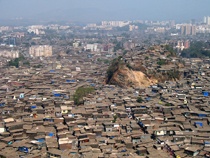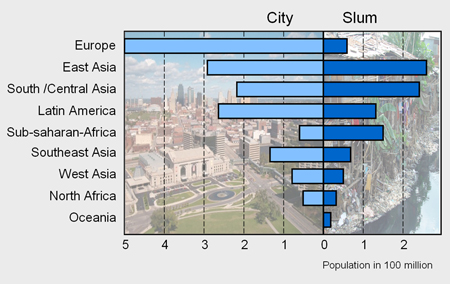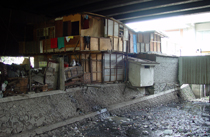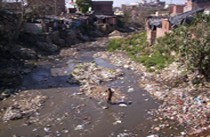2. Urbanisation
Marginalisation
The increasing urbanisation in developing countries is accompanied by a growing marginalisation of broad classes of population. Based on the continuing migration into cities, population pressure increases on an enormous scale and leads to a serious deficit of housing space. This brings forward the marginalisation and the development of marginal settlements at the periphery of mega cities in the Third World (Latz 2007).
Marginalization as an increasing problem of urbanization
Marginal settlements show the highest population density of the world (the Slum Dharavi in Mumbai 25 000 P/km², average density in Munich (no slum) 3 955 P/km²). Today, about 40% to 65% of the metropolitan population is living in marginal settlements (for a global distribution of the slum population see graph) (Bauer et al. 2005, Latz 2007).

Slum in Rio.
Photo: Andreas Nilsson |

Slum in Mumbai.
Photo: Joel Newell |
Within any city significant social differences among districts often exist. The "better" neighbourhoods become more and more separated enclaves, so called "gated communities". Out of such segregations a divided city is gradually formed (Gresh 2007).

Own illustration, Source: Claaßen 2008
The marginal neighbourhoods show significant deficits in technical and social infrastructure: there are no schools, hospitals and public transportation. Especially the drinking water supply is problematic, because the resources of the urban areas are not sufficient. In addition, the inadequate infrastructural planning inhibits the water-connection of many marginal settlements, so that the water supply has to be replaced by an expensive private road tanker. The insufficient hygienic conditions as well as uncontrolled sewage and waste disposal without sewage plants furthermore promotes the spread of diseases (diarrhoea, typhus, cholera, in 1994 there was a pestilence outbreak in Surat/India) (Bauer et al. 2005, Latz 2007).

Housing in Jakarta, Indonesia.
Photo: Jonathan McIntosh |

Stream within a slum.
Source: Wikimedia |
The energy supply is partly "guaranteed" by taping wires and distributors. Waste wood or propane gas serve as sources of energy and heat (Latz 2007).
The uncontrolled growth of marginal settlements entails a high health risk. People living in slums - where a large population, but not all, of the urban poor live - have worse health outcomes and are more likely to be affected by child mortality and acute respiratory illnesses than their non-slum counterparts (Bauer et al. 2005, UN-HABITAT 2006).
80% of the people in this area work in the informal sector and earn a poor living collecting waste, polishing shoes, washing cars and selling beverages or groceries. The work can be on a daily or hourly basis, there are no employment contracts, no dismissal protection and also no health or social insurance. A high unemployment rate is also characteristic (Claaßen 2008, Latz 2007).
Informal Sector
Alternative work sector of the marginalised population especially in developing countries. Jobs are carried out without social security and taxes. It ranges over all economic sectors and includes organ donations, child labour, prostitution and begging.
In cities of the developing world, one out of every four households lives in poverty, 40% of African urban households and 25% of Latin American urban households are living below the locally defined poverty lines; 37% of the population of the developing world is employed within the informal sector (UN-HABITAT 2001).
Pauperism, starvation and malnourishment are common, and furthermore those neighbourhoods are a focus of drug consumption, crime and prostitution as well as HIV disease and family degeneration (Bauer et al. 2005, Claaßen 2008, Latz 2007, UN-HABITAT 2006).
Are marginal neighbourhoods politically inaccessible?
The urban or the state authority has retreated largely from the marginalized areas. This withdrawal and more city-wide processes carry the risk that large-scale agglomerations will get uncontrollable not only in economic and social terms but also politically and therefore become ungovernable (Bronger 1996).
Many cities are already facing serious constraints on infrastructure and social services. There is the very real prospect that huge cities could become the principle incubators of social unrest in the decades ahead. Planning will become increasingly essential as increasingly active municipal governments will be needed (De Blij, Murphy 2003).
Tasks: 1. Describe the graphic on urban and slum population according to regions.
2. Construct a cause-effect diagram to show the origin and problems of marginal settlements.
3. Evaluate the different strategies of the administration to alleviate housing problems.
